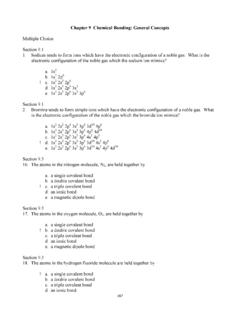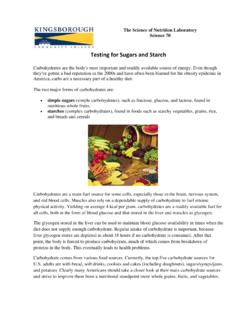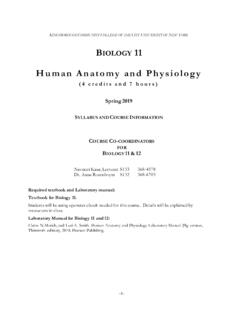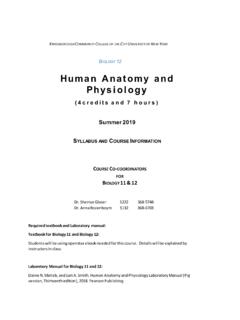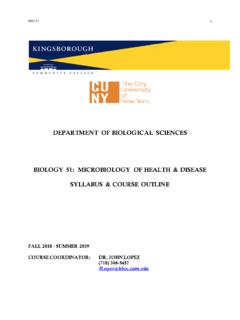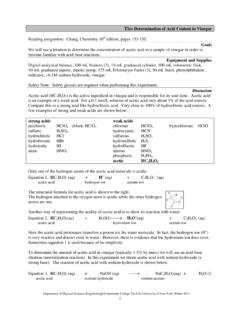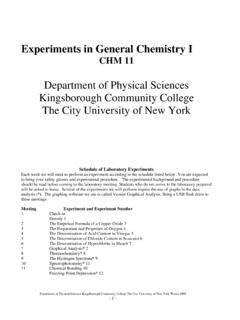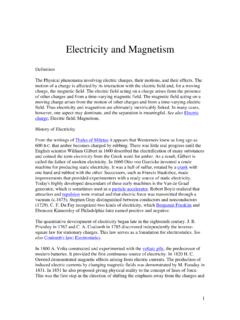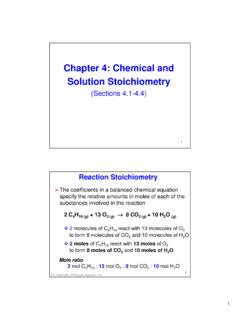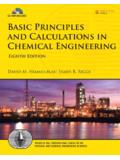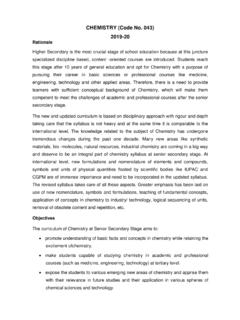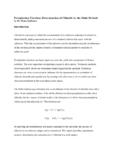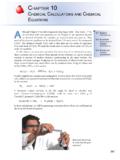Transcription of Experiment 5 Kinetics: The Oxidation of Iodide by Hydrogen ...
1 - 1 - Experiment 5 Kinetics: The Oxidation of Iodide by Hydrogen Peroxide Goals To determine the differential rate law for the reaction between Iodide and Hydrogen peroxide in an acidic environment.
2 To determine the activation energy and pre-exponential factor for the reaction. To determine the effect of a catalyst on the rate of reaction. Discussion When Hydrogen peroxide is added to a solution of potassium Iodide , the Iodide ions are slowly oxidized according to the equation: 2222potassium iodidehydrochloric acidhydrogen peroxideiodinecolorlesscolorlesscolorole ssyellow-+iodideMolecular equation: 2KI(aq) + 2 HCl(aq) + H O (aq) I (s) + 2H O(l)Net ionic equation: 2I (aq) + 2H (a 2222hydrogen peroxideiodineq) + H O (aq) I (s) + 2H O(l) The rate law for this reaction should include the concentrations of Iodide , Hydrogen ion, and Hydrogen perioxide.
3 However, if the concentration of H+ is held constant throughout the Experiment then its effect will not appear in the rate law. This results in a relatively simple rate law: rate = k[I ]n[H2O2]m[H+]p simplifies to: rate = k'[I ]n[H2O2]m where k' = k[H+]p Part 1: Determination of the Rate Law The rate law for the reaction between Iodide ions and Hydrogen peroxide can be determined by carrying out experiments in which the concentrations of Iodide and peroxide are varied. For example, consider the following reaction and data: A + B P Rate =k[A]n[B]m Experiment [A]0 [B]0 Initial rate Ms1 2 3 For this reaction, doubling the initial concentration of reactant A doubles the initial rate of reaction (experiments 1 and 2).
4 This relationship corresponds to n=1. Likewise, doubling the initial concentration of B has the effect of quadrupling the initial rate (experiments 2 and 3). This corresponds to m=2. We can now write the differential rate law for this reaction as: rate = k[A][B]2 The reaction is said to be first order in A and second order in B. Overall, the order of the reaction is 3. The value of the rate constant k can be determined by using the known values of n and m: 2 Ratek=[A][B] We can use the given initial concentrations and initial rate for each Experiment and determine the value of k for each Experiment .
5 For the study we will perform, the reaction between Iodide and Hydrogen peroxide, there are several experimental requirements: 1. The acidity of the solution must be maintained at a constant level so that the concentration of H+ is constant. 2. The temperature of the reactants must be the same for all runs. The rate constant is dependent on the temperature of the solution. Since the heat of reaction is relatively small for this reaction the temperature should remain relatively constant throughout the process.
6 If this were not the case then we would need to place the reaction in a constant temperature bath. 3. The reverse reaction must be suppressed. Forward reaction: 2I + 2H+ + H2O2 I2 + 2H2O Reverse reaction: I2 + 2H2O 2I + 2H+ + H2O2 (negligible) If the concentration of iodine (I2) is allowed to build up as the reaction proceeds then the rate of the reverse reaction will increase and an equilibrium mixture will result. Any rate measured for the reaction under such conditions will not represent the rate of the forward reaction but the net difference between the forward and reverse rates.
7 In this reaction, however, we can ignore the reverse reaction because the equilibrium position is so far on the I2 side that the reaction above does not take place to any appreciable extent. time 4. We need a method to accurately measure the rate of reaction. The addition of thiosulfate ions (S2O32 ) allows an accurate measurement of the rate at which the peroxide- Iodide reaction is taking place. Suppose that you add a small and known amount of thiosulfate ion to the original mixture of peroxide and Iodide .
8 Iodine is produced slowly by the reaction between peroxide and Iodide ions and the thiosulfate ions immediately react with the iodine as it is produced: 2-2--22346iodideiodinethiosulfatedithion atecolorlessyellowcolorlesscolorlessI + 2S O 2I + S O fast reaction As long as excess thiosulfate ions are present in the solution, no free iodine can accumulate because it is immediately turned into Iodide ions which are colorless. The thiosulfate ions are the limiting reagent.
9 So once all the thiosulfate ions are consumed, iodine starts to form in the solution. Iodine is a pale yellow. If starch is added to the solution then a more dramatic blue solution is formed by the complex of starch iodine. The color change is sharp, and the time elapsed to this point is determined simply by use of a timer. The time from the addition of the peroxide solution to the appearance of the blue color is t for the reaction. Since the stoichiometry of the thiosulfate iodine and the peroxide Iodide reactions is known, it is not difficult to calculate how many moles of peroxide were reduced in the known interval of time.
10 Consequently, the average rate (moles of Hydrogen peroxide consumed per liter per second) of the reaction during this period can be calculated. []22 HORate = - t For the peroxide Iodide reaction the average rate of the reaction over the period taken for the measurement is a good approximation of the initial reaction rate. change in time, measured with a stopwatch change in peroxide concentration, calculated from known amounts of reactants - 3.
